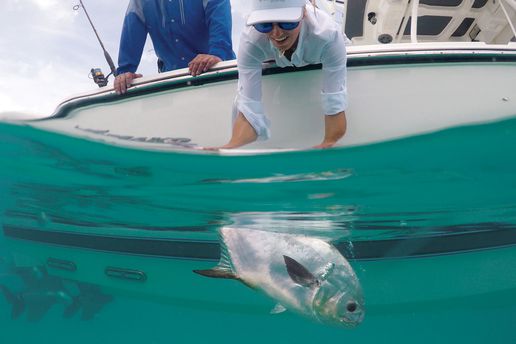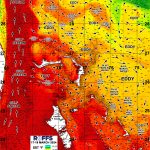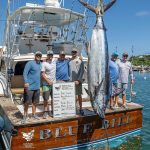Article Courtesy: saltwatersportsman.com | Originally Published: 9/25/20 | Click here for original article
Double Your Catch
Look at the big picture to double or triple your catch.
Catching a billfish, large dolphin, cobia or other top-tier gamefish often creates tunnel vision, with the sole focus on quarry and angler. However, such directed focus may actually diminish your catches over the long run. Consider a companion fish or two lurking near the hooked one that goes unnoticed by the crew.
And while landing a trophy is certainly a feat, scoring a double or triple is even more of an accomplishment.
Sailfish Savvy
Designating a second angler to cast behind a hooked fish is proven to score companion fish. Jeffrey Liederman, an accomplished billfishing authority aboard Sand Man, a 63 Spencer based in Miami, is a proponent of the tactic.
“When our team hooks a sailfish, I always assume there’s at least one more with it, or maybe two, three or more,” he says. “We keep multiple baits in play when fighting a fish, from kites to flat lines and even pitch-bait rods.
“Where to cast that second bait depends on what the hooked sailfish is doing,” says Liederman. “In a perfect world, I’d like for that bait to land where a sailfish crashes after a jump. The splashing and the regurgitation from the sailfish excites others into feeding. When a frantic live bait appears, they’re all over it.
Similar to South Florida sailfish, white marlin doubles and triples often come from pitch-baiting to hooked fish. “Jumpin’” John Oughton, a white marlin veteran out of Ocean City, Maryland, says: “When we put a second rod into action for white marlin, it will be one of our flat lines. When I hook a white, I put the boat into a wide turn to swing toward the hooked fish. That keeps the trolling spread in play outside the turn, leaving me clean water on the inside of the turn to drop-back the flat-line bait into. We free-spool the bait back to the hooked fish. Roughly 60 to 70 percent of the time, we pick up a double that way.
“An offshoot of this tactic is what we call prospecting,” Oughton says. “When we’re trolling in a fishy-looking area, we’ll repeatedly drop a bait back and retrieve it, playing off the dredges. We strive to make it look like a bait separated from its school (dredge). It’s successful for white marlin we don’t see lurking back there.”
Fun-Fish Pitch
Casting for companion fish isn’t solely for the billfish crowd. When a sizable dolphin is hooked, pitching a bait behind it could score its mate, even if it appears nothing else is around. Simply cast the bait toward the tail of the fish, free-spool, and get ready for a pickup. If nothing happens, recast the bait, free-spool some more, and place the outfit in a holder. Companion fish sometimes hold off to the side or deep.
The commotion from the hooked dolphin might excite any companions into eating, or even attract a fresh push of fish. Many times, it’s the unattended rod in the holder that scores, surprising everyone aboard as they focus on the fight with the hooked fish.
King Foolery
King mackerel are notorious for stalking hooked companions, though they’re rarely sighted due to deep fights. A hooked king excites others.
Toward a fight’s end stage, pitch out a second live bait or jig. Prepare for a sudden strike. It’s the same when jigging for kings: As one comes near the boat, drop a jig beneath it and work it radically. The strike should be almost instantaneous.
Fast Company
Capt. Andrew Tipler, a shallow-water and wreck specialist in Cudjoe Key, Florida, says to never discount the odds of a companion fish or two stalking a hooked one, permit being a prime example. “Wreck permit tend to travel in large schools, and it’s not uncommon to have a single or pair follow one being played near the boat, at least to where they’re close enough to be seen,” Tipler says. “They move fast, so if you’re not ready to capitalize on a second fish, it will be gone by the time you prep a second outfit. Have a friend poised with a spinner rigged with a crab. Even if you don’t see a second fish, have him cast behind the hooked permit and let the crab drift.”
Tipler says there are two key chances to double up on permit. The first is when you spot a school. He suggests casting the primary outfit, followed closely by the second one. “What happens is a hooked permit startles the school,” he says. “That’s why it’s crucial to try for that second hookup rapid fire, right after the first bait hits the water. The permit will then settle after a while. The second opportunity for a double may present itself when the hooked fish comes 30 to 40 feet from the boat. This is when the second bait should be presented.”
A different fishing scenario: Cobia often hang on bull sharks. “If you hook the shark accidentally, don’t treat it like a lost cause,” Tipler says. “Be prepared, as it may present a golden opportunity to catch a cobia, or maybe several. Bull sharks and cobia seem to go hand in hand. If bull sharks are on a wreck, cobia are bound to be with them.”
A tactic increasing in popularity is to catch a bull shark on heavy tackle and look for cobia in the vicinity as the shark nears the boat. You just need a strong volunteer to battle the shark, a main caster, and a backup player. That’s all part of playing the numbers game.








